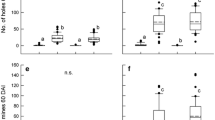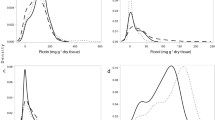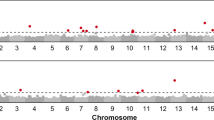Abstract
Plants have evolved a variety of defences to reduce losses to herbivores and pathogens. The benefits of these may, however, be modified by resistance evolution in antagonists, changes in antagonist fauna, context-dependent “costs of defence”, and by interactions between antagonists. In Barbarea vulgaris (Brassicaceae), the so-called “G-type” produces triterpenoid saponins that deter important specialist insect herbivores, whereas the “P-type” produces other saponins and are not insect-resistant. In contrast, P-type plants are predominantly resistant to the biotroph pathogen Albugo sp., causing white blister rust, whilst most G-type plants are susceptible. In a field experiment with F3 hybrids between G and P-plants, we tested whether the two resistances are functionally coupled, leads to less disease and herbivory and to better plant performance, and whether insect herbivores and the pathogen interact in their effects on plant performance. The Albugo and insect resistances varied continuously between the F3 plants and mapped to different linkage groups, indicating independent mechanisms and evolution. Plants with high Albugo resistance produced more biomass and survived better than more susceptible plants. Albugo DNA was detected in surface-sterilized green siliques, indicating systemic and sometimes non-symptomatic infection. Plants with high insect resistance were slightly less damaged by herbivores, but did not grow or survive better than more susceptible plants. Interactions between Albugo and insect herbivores did not affect plant performance. In contrast to the Albugo resistance, which clearly benefited the plants, our results show that the saponin-based insect resistance did convey any benefit under the given conditions despite its deterrent effects in controlled experiments.







Similar content being viewed by others
References
Agerbirk N, Olsen CE, Nielsen JK (2001) Seasonal variation in leaf glucosinolates and insect resistance in two types of Barbarea vulgaris ssp. arcuata. Phytochemistry 58:91–100. https://doi.org/10.1016/S0031-9422(01)00151-0
Agerbirk N, Olsen CE, Bibby BM, Frandsen HO, Brown LD, Nielsen JK, Renwick JAA (2003a) A saponin correlated with variable resistance of Barbarea vulgaris to the diamondback moth Plutella xylostella. J Chem Ecol 29:1417–1433
Agerbirk N, Ørgaard M, Nielsen JK (2003b) Glucosinolates, flea beetle resistance, and leaf pubescence as taxonomic characters in the genus Barbarea (Brassicaceae). Phytochemistry 63:69–80. https://doi.org/10.1016/S0031-9422(02)00750-1
Alexander HM, Burdon JJ (1984) The effect of disease induced by Albugo candida (white rust) and Peronospora parasitica (downy mildew) on the survival and reproduction of Capsella burna-pastoris (shepherd’s purse). Oecologia 64:314–318
Augustin JM, Kuzina V, Andersen SB, Bak S (2011) Molecular activities, biosynthesis and evolution of triterpenoid saponins. Phytochemistry 72:435–457. https://doi.org/10.1016/j.phytochem.2011.01.015
Augustin JM, Drok S, Shinoda T, Sanmiya K, Nielsen JK, Khakimov B, Olsen CE, Hansen EH, Kuzina V, Ekstrøm CT, Hauser T, Bak S (2012) UDP-glycosyltransferases from the UGT73C subfamily in Barbarea vulgaris catalyze sapogenin 3-O-glucosylation in saponin-mediated insect resistance. Plant Physiol 160:1881–1895. https://doi.org/10.1104/pp.112.202747
Badenes-Pérez FR, López-Pérez JA (2018) Resistance and susceptibility to powdery mildew, root-knot nematode, and western flower thrips in two types of winter cress (Brassicaceae). Crop Prot 110:41–47
Badenes-Perez FR, Gershenzon J, Heckel DG (2014a) Insect attraction versus plant defense: young leaves high in glucosinolates stimulate oviposition by a specialist herbivore despite poor larval survival due to high saponin content. PLoS ONE 9:e95766. https://doi.org/10.1371/journal.pone.0095766
Badenes-Perez FR, Reichelt M, Gershenzon J, Heckel DG (2014b) Using plant chemistry and insect preference to study the potential of Barbarea (Brassicaceae) as a dead-end trap crop for diamondback moth (Lepidoptera: Plutellidae). Phytochemistry 98:137–144. https://doi.org/10.1016/j.phytochem.2013.11.009
Badenes-Pérez FR, Márquez BP, Petitpierre E (2017) Can flowering Barbarea spp. (Brassicaceae) be used simultaneously as a trap crop and in conservation biological control? J Pest Sci 90:623–633. https://doi.org/10.1007/s10340-016-0815-y
Barton NH, Hewitt GM (1985) Analysis of hybrid zones. Annu Rev Ecol Syst 16:113–148. https://doi.org/10.1146/annurev.es.16.110185.000553
Belhaj K, Cano LM, Prince DC, Kemen A, Yoshida K, Dagdas YF, Etherington GJ, Schoonbeek H-J, van Esse HP, Jones JDG, Kamoun S, Schornack S (2017) Arabidopsis late blight: infection of a nonhost plant by Albugo laibachii enables full colonization by Phytophthora infestans. Cell Microbiol. https://doi.org/10.1111/cmi.12628
Borhan MH, Holub EB, Beynon JL, Rozwadowski K, Rimmer SR (2004) The arabidopsis TIR-NB-LRR gene RAC1 confers resistance to Albugo candida (white rust) and is dependent on EDS1 but not PAD4. Mol Plant Microbe Interact 17:711–719. https://doi.org/10.1094/MPMI.2004.17.7.711
Borhan MH, Gunn N, Cooper A, Gulden S, Tör M, Rimmer SR, Holub EB (2008) WRR4 encodes a TIR-NB-LRR protein that confers broad-spectrum white rust resistance in Arabidopsis thaliana to four physiological races of Albugo candida. Mol Plant Microbe Interact 21:757–768. https://doi.org/10.1094/MPMI-21-6-0757
Bradbury PJ, Zhang Z, Kroon DE, Casstevens TM, Ramdoss Y, Buckler ES (2007) TASSEL: software for association mapping of complex traits in diverse samples. Bioinformatics 23:2633–2635. https://doi.org/10.1093/bioinformatics/btm308
Byrne SL, Erthmann PØ, Agerbirk N, Bak S, Hauser TP, Nagy I, Paina C, Asp T (2017) The genome sequence of Barbarea vulgaris facilitates the study of ecological biochemistry. Sci Rep 7:40728. https://doi.org/10.1038/srep40728
Chattopadhyay C, Kolte SJ, Waliyar F (2015) Diseases of edible oilseed crops. CRC Press, Taylor and Francis Group, Boca Raton
Chen M-S (2008) Inducible direct plant defense against insect herbivores: a review. Insect Sci 15:101–114. https://doi.org/10.1111/j.1744-7917.2008.00190.x
Chisholm ST, Coaker G, Day B, Staskawicz BJ (2006) Host-microbe interactions: shaping the evolution of the plant immune response. Cell 124:803–814. https://doi.org/10.1016/j.cell.2006.02.008
Choi Y-J, Shin H-D, Ploch S, Thines M (2011) Three new phylogenetic lineages are the closest relatives of the widespread species Albugo candida. Fungal Biol 115:598–607. https://doi.org/10.1016/j.funbio.2011.02.006
Chou HM, Bundock N, Rolfe SA, Scholes JD (2000) Infection of Arabidopsis thaliana leaves with Albugo candida (white blister rust) causes a reprogramming of host metabolism. Mol Plant Pathol 1:99–113. https://doi.org/10.1046/j.1364-3703.2000.00013.x
Christensen S, Heimes C, Agerbirk N, Kuzina V, Olsen CE, Hauser TP (2014) Different geographical distributions of two chemotypes of Barbarea vulgaris that differ in resistance to insects and a pathogen. J Chem Ecol 40:491–501. https://doi.org/10.1007/s10886-014-0430-4
Christensen S, Sørensen H, Munk KR, Hauser TP (2016) A hybridisation barrier between two evolutionary lineages of Barbarea vulgaris (Brassicaceae) that differ in biotic resistances. Evol Ecol 30:887–904. https://doi.org/10.1007/s10682-016-9858-z
Christensen S, Enge S, Jensen KR, Müller C, Kiær LP, Agerbirk N, Heimes C, Hauser TP (2019) Different herbivore responses to two co-occurring chemotypes of the wild crucifer Barbarea vulgaris. Arthropod Plant Interact 13:19–30. https://doi.org/10.1007/s11829-018-9633-x
Crawley MJ (2007) The R Book. John Wiley and Sons, Ltd, Chichester
Dalby-Brown L, Olsen CE, Nielsen JK, Agerbirk N (2011) Polymorphism for novel tetraglycosylated flavonols in an eco-model crucifer, Barbarea vulgaris. J Agric Food Chem 59:6947–6956. https://doi.org/10.1021/jf200412c
Dangl JL, Holub EB, Debener T, Lehnackers H, Ritter C, Crute IR, Koncz C, Chua NH, Schell J (1992) Genetic definition of loci involved in Arabidopsis-pathogen interactions. In: Koncz C, Chua NH, Schell J (eds) Methods in Arabidopsis research. World Scientific Publishing Co, Singapore, pp 393–418
De Geyter E, Smagghe G, Rahbé Y, Geelen D (2012) Triterpene saponins of Quillaja saponaria show strong aphicidal and deterrent activity against the pea aphid Acyrthosiphon pisum. Pest Manag Sci 68:164–169. https://doi.org/10.1002/ps.2235
Ekabo OA, Farnsworth NR, Henderson TO, Mao G, Mukherjee R (1996) Antifungal and molluscicidal saponins from Serjania salzmanniana. J Nat Prod 59:431–435. https://doi.org/10.1021/np960208r
Erthmann PØ, Agerbirk N, Bak S (2018) A tandem array of UDP-glycosyltransferases from the UGT73C subfamily glycosylate sapogenins, forming a spectrum of mono- and bisdesmosidic saponins. Plant Mol Biol 97:37–55. https://doi.org/10.1007/s11103-018-0723-z
Evanno G, Regnaut S, Goudet J (2005) Detecting the number of clusters of individuals using the software STRUCTURE: a simulation study. Mol Ecol 14:2611–2620. https://doi.org/10.1111/j.1365-294X.2005.02553.x
Gershenzon J (1994) Metabolic costs of terpenoid accumulation in higher plants. J Chem Ecol 20:1281–1328. https://doi.org/10.1007/BF02059810
Giron D, Huguet E, Stone GN, Body M (2016) Insect-induced effects on plants and possible effectors used by galling and leaf-mining insects to manipulate their host-plant. J Insect Physiol 84:70–89. https://doi.org/10.1016/j.jinsphys.2015.12.009
Goławska S (2007) Deterrence and toxicity of plant saponins for the pea aphid Acyrthosiphon pisum Harris. J Chem Ecol 33:1598–1606. https://doi.org/10.1007/s10886-007-9333-y
Grace JB (2006) Structural equation modeling and natural systems. Cambridge University Press, Cambridge
Hasenbank M, Brandon A, Hartley S (2011) White butterfly (Pieris rapae) an the white rust Albugo candida on Cook’s scurvy grass (Lepidium oleraceum). N Z J Ecol 35:69–75
Hatcher PE (1995) Three-way interactions between plant pathogenic fungi, herbivorous insects and their host plants. Biol Rev 70:639–694. https://doi.org/10.1111/j.1469-185X.1995.tb01655.x
Hauser TP, Toneatto F, Nielsen JK (2012) Genetic and geographic structure of an insect resistant and a susceptible type of Barbarea vulgaris in western Europe. Evol Ecol 26:611–624. https://doi.org/10.1007/s10682-011-9515-5
Hauser TP, Christensen S, Heimes C, Kiaer LP (2013) Combined effects of arthropod herbivores and phytopathogens on plant performance. Funct Ecol 27:623–632. https://doi.org/10.1111/1365-2435.12053
Heimes C, Thiele J, van Mölken T, Hauser TP (2015) Interactive impacts of a herbivore and a pathogen on two resistance types of Barbarea vulgaris (Brassicaceae). Oecologia 177:441–452. https://doi.org/10.1007/s00442-014-3113-5
Heimes C, Agerbirk N, Sørensen H, van Mölken T, Hauser TP (2016) Ecotypic differentiation of two sympatric chemotypes of Barbarea vulgaris (Brassicaceae) with different biotic resistances. Plant Ecol 217:1055–1068. https://doi.org/10.1007/s11258-016-0631-8
Hostettmann K (1980) Saponins with molluscicidal activity from Hedera helix L. Helv Chim Acta 63:606–609. https://doi.org/10.1002/hlca.19800630307
Jacobson DJ, LeFebvre SM, Ojerio RS, Berwald N, Heikkinen E (1998) Persistent, systemic, asymptomatic infections of Albugo candida, an oomycete parasite, detected in three wild crucifer species. Can J Bot 76:739–750. https://doi.org/10.1139/b98-039
Khakimov B, Kuzina V, Erthmann PØ, Fukushima EO, Augustin JM, Olsen CE, Scholtalbers J, Volpin H, Andersen SB, Hauser TP, Muranaka T, Bak S (2015) Identification and genome organization of saponin pathway genes from a wild crucifer, and their use for transient production of saponins in Nicotiana benthamiana. Plant J 84:478–490. https://doi.org/10.1111/tpj.13012
Koornneef A, Pieterse CMJ (2008) Cross talk in defense signaling. Plant Physiol 146:839–844. https://doi.org/10.1104/pp.107.112029
Koricheva J (2002) Meta-analysis of sources of variation in fitness costs of plant antiherbivore defenses. Ecology 83:176. https://doi.org/10.2307/2680130
Kuzina V, Ekstrøm CT, Andersen SB, Nielsen JK, Olsen CE, Bak S (2009) Identification of defense compounds in Barbarea vulgaris against the herbivore Phyllotreta nemorum by an ecometabolomic approach. Plant Physiol 151:1977–1990. https://doi.org/10.1104/pp.109.136952
Kuzina V, Nielsen JK, Augustin JM, Torp AM, Bak S, Andersen SB (2011) Barbarea vulgaris linkage map and quantitative trait loci for saponins, glucosinolates, hairiness and resistance to the herbivore Phyllotreta nemorum. Phytochemistry 72:188–198. https://doi.org/10.1016/j.phytochem.2010.11.007
Lange CBA, Hauser TP, Deichmann V, Ørgaard M (2021) Hybridization and complex evolution of Barbarea vulgaris and related species (Brassicaceae). In review
Liu Q, Khakimov B, Cárdenas PD, Cozzi F, Olsen CE, Jensen KR, Hauser TP, Bak S (2019) The cytochrome P450 CYP72A552 is key to production of hederagenin-based saponins that mediate plant defense against herbivores. New Phytol 222:1599–1609. https://doi.org/10.1111/nph.15689
Marston A, Gafner F, Dossaji SF, Hostettmann K (1988) Fungicidal and molluscicidal saponins from Dolichos kilimandscharicus. Phytochemistry 27:1325–1326. https://doi.org/10.1016/0031-9422(88)80186-9
Martin SH, Jiggins CD (2017) Interpreting the genomic landscape of introgression. Curr Opin Genet Dev 47:69–74. https://doi.org/10.1016/j.gde.2017.08.007
Nielsen JK (1997a) Variation in defences of the plant Barbarea vulgaris and in counteradaptations by the flea beetle Phyllotreta nemorum. Entomol Exp Appl 82:25–35. https://doi.org/10.1046/j.1570-7458.1997.00110.x
Nielsen JK (1997b) Genetics of the ability of Phyllotreta nemorum larvae to survive in an atypical host plant, Barbarea vulgaris ssp. arcuata. Entomol Exp Appl 82:37–44. https://doi.org/10.1046/j.1570-7458.1997.00111.x
Nielsen JK, Nagao T, Okabe H, Shinoda T (2010) Resistance in the plant, Barbarea vulgaris, and counter-adaptations in flea beetles mediated by saponins. J Chem Ecol 36:277–285. https://doi.org/10.1007/s10886-010-9758-6
Pangesti N, Pineda A, Pieterse CMJ, Dicke M, van Loon JJA (2013) Two-way plant mediated interactions between root-associated microbes and insects: from ecology to mechanisms. Front Plant Sci 4:414. https://doi.org/10.3389/fpls.2013.00414
Panjabi-Massand P, Yadava SK, Sharma P, Kaur A, Kumar A, Arumugam N, Sodhi YS, Mukhopadhyay A, Gupta V, Pradhan AK, Pental D (2010) Molecular mapping reveals two independent loci conferring resistance to Albugo candida in the east European germplasm of oilseed mustard Brassica juncea. Theor Appl Genet 121:137–145. https://doi.org/10.1007/s00122-010-1297-6
Pieterse CMJ, Dicke M (2007) Plant interactions with microbes and insects: from molecular mechanisms to ecology. Trends Plant Sci 12:564–569. https://doi.org/10.1016/j.tplants.2007.09.004
Pieterse CMJ, Van der Does D, Zamioudis C, Leon-Reyes A, Van Wees SCM (2012) Hormonal modulation of plant immunity. Annu Rev Cell Dev Biol 28:489–521. https://doi.org/10.1146/annurev-cellbio-092910-154055
Ploch S, Thines M (2011) Obligate biotrophic pathogens of the genus Albugo are widespread as asymptomatic endophytes in natural populations of Brassicaceae. Mol Ecol 20:3692–3699. https://doi.org/10.1111/j.1365-294X.2011.05188.x
Prince DC, Rallapalli G, Xu D, Schoonbeek H-J, Çevik V, Asai S, Kemen E, Cruz-Mireles N, Kemen A, Belhaj K, Schornack S, Kamoun S, Holub EB, Halkier BA, Jones JDG (2017) Albugo-imposed changes to tryptophan-derived antimicrobial metabolite biosynthesis may contribute to suppression of non-host resistance to Phytophthora infestans in Arabidopsis thaliana. BMC Biol 15:20. https://doi.org/10.1186/s12915-017-0360-z
Pritchard JK, Stephens M, Donnelly P (2000) Inference of population structure using multilocus genotype data. Genetics 155:945–959. https://doi.org/10.1093/genetics/155.2.945
R Development Core Team R (2020) R: A language and environment for statistical computing. R Foundation for Statistical Computing, Vienna, Austria
Renwick JAA (2002) The chemical world of crucivores: lures, treats and traps. Entomol Exp Appl 104:35–42. https://doi.org/10.1046/j.1570-7458.2002.00988.x
Shinoda T, Nagao T, Nakayama M, Serizawa H, Koshioka M, Okabe H, Kawai A (2002) Identification of a triterpenoid saponin from a crucifer, Barbarea vulgaris, as a feeding deterrent to the diamondback moth, Plutella xylostella. J Chem Ecol 28:587–599
Strauss SY, Rudgers JA, Lau JA, Irwin RE (2002) Direct and ecological costs of resistance to herbivory. Trends Ecol Evol (amst) 17:278–285. https://doi.org/10.1016/S0169-5347(02)02483-7
Sylwia G, Leszczynski B, Wieslaw O (2006) Effect of low and high-saponin lines of alfalfa on pea aphid. J Insect Physiol 52:737–743. https://doi.org/10.1016/j.jinsphys.2006.04.001
Thaler JS, Karban R, Ullman DE, Boege K, Bostock RM (2002) Cross-talk between jasmonate and salicylate plant defense pathways: effects on several plant parasites. Oecologia 131:227–235. https://doi.org/10.1007/s00442-002-0885-9
Thaler JS, Humphrey PT, Whiteman NK (2012) Evolution of jasmonate and salicylate signal crosstalk. Trends Plant Sci 17:260–270. https://doi.org/10.1016/j.tplants.2012.02.010
Thompson JN (2005) The geographic mosaic of coevolution. University of Chicago Press, Chicago
Toneatto F, Nielsen JK, Ørgaard M, Hauser TP (2010) Genetic and sexual separation between insect resistant and susceptible Barbarea vulgaris plants in Denmark. Mol Ecol 19:3456–3465. https://doi.org/10.1111/j.1365-294X.2010.04760.x
Toneatto F, Hauser TP, Nielsen JK, Ørgaard M (2012) Genetic diversity and similarity in the Barbarea vulgaris complex (Brassicaceae). Nord J Bot 30:506–512. https://doi.org/10.1111/j.1756-1051.2012.01546.x
van Mölken T, Heimes C, Hauser TP, Sundelin T (2014a) Phylogeny of an Albugo sp. infecting Barbarea vulgaris in Denmark and its frequency of symptom development in natural populations of two evolutionary divergent plant types. Fungal Biol 118:340–347. https://doi.org/10.1016/j.funbio.2014.01.008
van Mölken T, Kuzina V, Munk KR, Olsen CE, Sundelin T, van Dam NM, Hauser TP (2014b) Consequences of combined herbivore feeding and pathogen infection for fitness of Barbarea vulgaris plants. Oecologia 175:589–600. https://doi.org/10.1007/s00442-014-2928-4
Vos IA, Moritz L, Pieterse CMJ, Van Wees SCM (2015) Impact of hormonal crosstalk on plant resistance and fitness under multi-attacker conditions. Front Plant Sci 6:639. https://doi.org/10.3389/fpls.2015.00639
War AR, Paulraj MG, Ahmad T, Buhroo AA, Hussain B, Ignacimuthu S, Sharma HC (2012) Mechanisms of plant defense against insect herbivores. Plant Signal Behav 7:1306–1320. https://doi.org/10.4161/psb.21663
Wei X, Zhang X, Shen D, Wang H, Wu Q, Lu P, Qiu Y, Song J, Zhang Y, Li X (2013) Transcriptome analysis of Barbarea vulgaris infested with diamondback moth (Plutella xylostella) larvae. PLoS ONE 8:e64481. https://doi.org/10.1371/journal.pone.0064481
Zhang X, Liu T, Wei X, Qiu Y, Song J, Wang H, Shen D, Agerbirk N, Li X (2015) Expression patterns, molecular markers and genetic diversity of insect-susceptible and resistant Barbarea genotypes by comparative transcriptome analysis. BMC Genomics 16:486. https://doi.org/10.1186/s12864-015-1609-y
Zhang H, Dugé de Bernonville T, Body M, Glevarec G, Reichelt M, Unsicker S, Bruneau M, Renou J-P, Huguet E, Dubreuil G, Giron D (2016) Leaf-mining by Phyllonorycter blancardella reprograms the host-leaf transcriptome to modulate phytohormones associated with nutrient mobilization and plant defense. J Insect Physiol 84:114–127. https://doi.org/10.1016/j.jinsphys.2015.06.003
Zhang H, Guiguet A, Dubreuil G, Kisiala A, Andreas P, Emery RJN, Huguet E, Body M, Giron D (2017) Dynamics and origin of cytokinins involved in plant manipulation by a leaf-mining insect. Insect Sci 24:1065–1078. https://doi.org/10.1111/1744-7917.12500
Züst T, Agrawal AA (2017) Trade-offs between plant growth and defense against insect Herbivory: an emerging mechanistic synthesis. Annu Rev Plant Biol 68:513–534. https://doi.org/10.1146/annurev-arplant-042916-040856
Acknowledgements
Many thanks to Professor Sven Bode Andersen, who unfortunately passed away before publishing, for guiding the genetic analyses. Also, thanks to Morten Læssøe Stephensen, who took care of the plants in the greenhouse, Mai-Britt Sauer and Mads Nielsen, who transplanted into the field, Vinnie Deichmann, who extracted DNA, and Karen R Munk, who weighed the plants. This work was carried out as part of Stina Christensen’s PhD projects, funded by the Faculty of Science, University of Copenhagen, and by a grant from the Danish Council for Independent Research, Technology and Production Sciences to Thure Hauser (No. 09-065899).
Funding
This work was carried out as part of Stina Christensen’s PhD projects, funded by the Faculty of Science, University of Copenhagen, and by a grant from The Danish Council for Independent Research, Technology and Production Sciences to Thure Hauser (No. 09-065899).
Author information
Authors and Affiliations
Corresponding author
Ethics declarations
Conflict of interest
The authors declare that they have no conflict of interest.
Consent for publication
Yes.
Additional information
Communicated by Heikki Hokkanen.
Publisher's Note
Springer Nature remains neutral with regard to jurisdictional claims in published maps and institutional affiliations.
Supplementary Information
Below is the link to the electronic supplementary material.
Rights and permissions
About this article
Cite this article
Hauser, T.P., Christensen, S., Kuzina, V. et al. Effects of a saponin-based insect resistance and a systemic pathogen resistance on field performance of the wild crucifer Barbarea vulgaris. Arthropod-Plant Interactions 15, 683–698 (2021). https://doi.org/10.1007/s11829-021-09858-w
Received:
Accepted:
Published:
Issue Date:
DOI: https://doi.org/10.1007/s11829-021-09858-w




